新教材高一英语Unit 4说课教案
- 格式:doc
- 大小:60.50 KB
- 文档页数:8
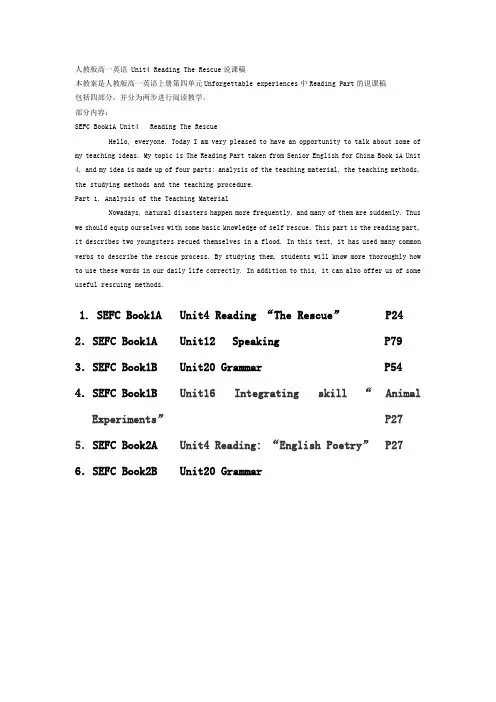
人教版高一英语 Unit4 Reading The Rescue说课稿本教案是人教版高一英语上册第四单元Unforgettable experiences中Reading Part的说课稿包括四部分,并分为两步进行阅读教学。
部分内容:SEFC Book1A Unit4 Reading The RescueHello, everyone. Today I am very pleased to have an opportunity to talk about some of my teaching ideas. My topic is The Reading Part taken from Senior English for China Book 1A Unit 4, and my idea is made up of four parts: analysis of the teaching material, the teaching methods, the studying methods and the teaching procedure.Part 1. Analysis of the Teaching MaterialNowadays, natural disasters happen more frequently, and many of them are suddenly. Thus we should equip ourselves with some basic knowledge of self rescue. This part is the reading part, it describes two youngsters recued themselves in a flood. In this text, it has used many common verbs to describe the rescue process. By studying them, students will know more thoroughly how to use these words in our daily life correctly. In addition to this, it can also offer us of some useful rescuing methods.1. SEFC Book1A U nit4 Reading “The Rescue” P24 2.SEFC Book1A Unit12 Speaking P79 3.SEFC Book1B Unit20 Grammar P54 4.SEFC Book1B Unit16 Integrating skill“Animal Experiments” P27 5.SEFC Book2A Unit4 Reading: “English Poetry” P27 6.SEFC Book2B Unit20 Grammar。
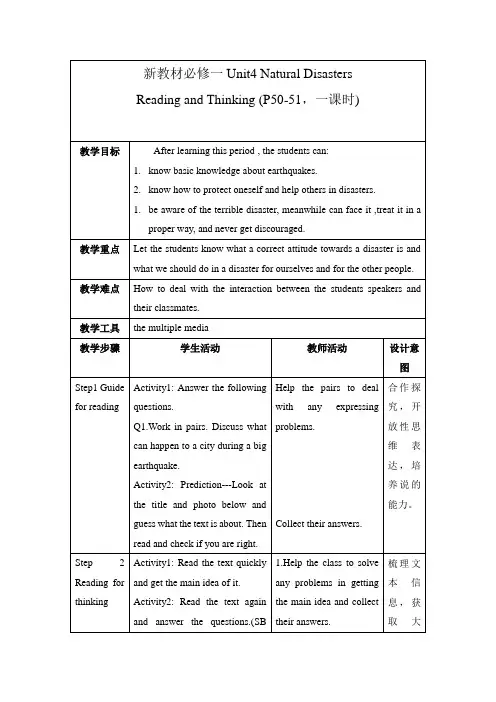
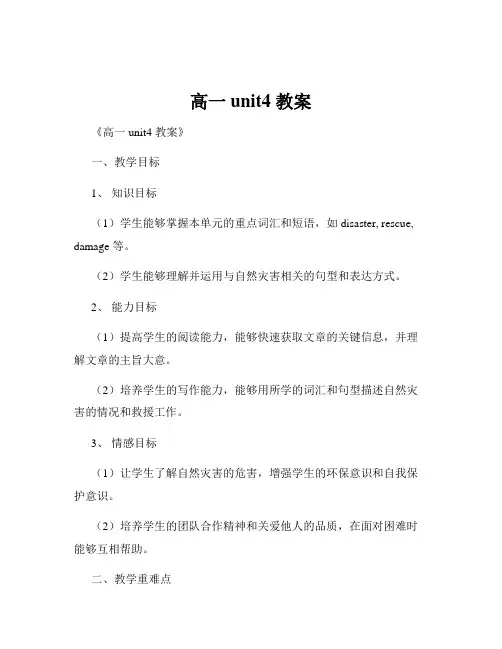
高一unit4 教案《高一 unit4 教案》一、教学目标1、知识目标(1)学生能够掌握本单元的重点词汇和短语,如 disaster, rescue, damage 等。
(2)学生能够理解并运用与自然灾害相关的句型和表达方式。
2、能力目标(1)提高学生的阅读能力,能够快速获取文章的关键信息,并理解文章的主旨大意。
(2)培养学生的写作能力,能够用所学的词汇和句型描述自然灾害的情况和救援工作。
3、情感目标(1)让学生了解自然灾害的危害,增强学生的环保意识和自我保护意识。
(2)培养学生的团队合作精神和关爱他人的品质,在面对困难时能够互相帮助。
二、教学重难点1、教学重点(1)重点词汇和短语的用法,如 be trapped in, a number of 等。
(2)课文的理解和分析,掌握文章的结构和主要内容。
2、教学难点(1)如何引导学生正确运用所学词汇和句型进行书面表达。
(2)培养学生对自然灾害的应对能力和防范意识。
三、教学方法1、任务驱动法通过布置各种任务,如阅读、写作、讨论等,让学生在完成任务的过程中掌握知识和技能。
2、情景教学法创设与自然灾害相关的情景,让学生身临其境,更好地理解和感受课文内容。
3、合作学习法组织学生进行小组合作学习,共同探讨问题,培养学生的合作精神和沟通能力。
四、教学过程1、导入(5 分钟)通过播放一段关于自然灾害的视频,如地震、洪水等,引起学生的兴趣,然后提问学生对自然灾害的了解和感受,导入本单元的主题。
2、词汇学习(15 分钟)(1)展示本单元的重点词汇和短语,如disaster, rescue, damage 等,让学生跟读并记忆。
(2)通过图片、例句等方式帮助学生理解词汇的用法和含义。
(3)进行词汇练习,如填空、选择等,巩固学生对词汇的掌握。
3、阅读教学(20 分钟)(1)让学生快速阅读课文,回答一些简单的问题,如文章的主题是什么,主要讲述了哪些自然灾害等。
(2)仔细阅读课文,分析文章的结构和段落大意,引导学生理解文章的细节内容。
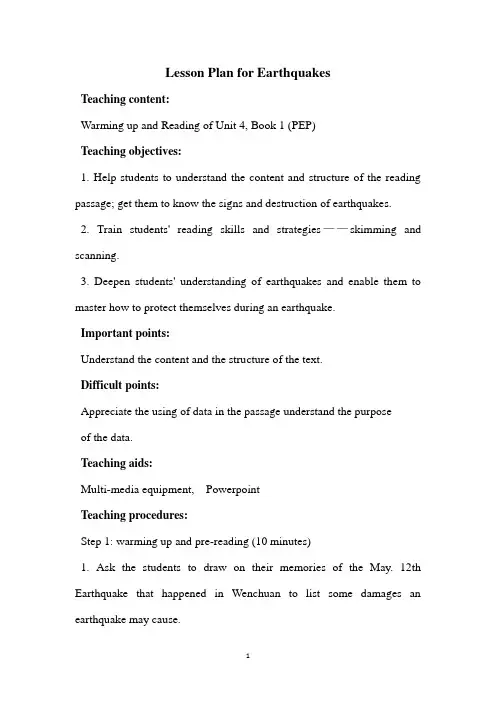
Lesson Plan for EarthquakesTeaching content:Warming up and Reading of Unit 4, Book 1 (PEP)Teaching objectives:1. Help students to understand the content and structure of the reading passage; get them to know the signs and destruction of earthquakes.2. Train students' reading skills and strategies——skimming and scanning.3. Deepen students' understanding of earthquakes and enable them to master how to protect themselves during an earthquake.Important points:Understand the content and the structure of the text.Difficult points:Appreciate the using of data in the passage understand the purposeof the data.Teaching aids:Multi-media equipment, PowerpointTeaching procedures:Step 1: warming up and pre-reading (10 minutes)1. Ask the students to draw on their memories of the May. 12th Earthquake that happened in Wenchuan to list some damages an earthquake may cause.2. Show a map of the six plates in the world and explain what an earthquake is.Take San Francisco for example and ask a student to explain how the earthquake in 1906 happened3. Watch video clip from TV series about Tangshan Earthquake and find the strange things that happened before the earthquake.Step 2: global reading (8 minutes)1. Read the title of the reading passage-A Night The Earth Didn't Sleep and predict the content of the passage.2. Skim the passage to get the main idea and the way the text is organized.3. Divide the text into three parts according to time order.part 1 Signs or events before the quakepart 2 Destruction or damage during the quake.part 3 Rescue after the quakeStep 3: Careful reading (15 minutes)1. Read the first part carefully and fill in the chartIn the well water, cracks, smelly gas, well rose and fell, came outIn the farmyard chickens, pigs, mice, fish, too nervous to eat, run, jumpIn the sky bright lights, the sound of planesIn the city water pipes, cracked and burstStep 4: summary of the text 3 minutesSeveral days before July28th,1976, many strange things happened in Tangshan. They were signs for the earthquake_. But people in the city of Tangshan thought little of them.at3:42 am that day, the earth began to shake, which destroyed the city. Many people including workers and doctors, came to rescue those who were trapped under the ruins. Later that afternoon, another big quake struck Tangshan. More people were killed or injured and more buildings fell_down. Soldiers were called in to help the rescue workers. Teams_ were organized to dig out the trapped and bury_ the dead. Slowly, the city began to breathe again.Step5:post- -reading discussion(8 minutes)Discuss in groups of 4-6 students to work out some practical measures to prevent themselves from getting injured or killed.Ask some students to share their ideas.Step6: homework (1 minute)Ask students to finish exercise1.2after class。
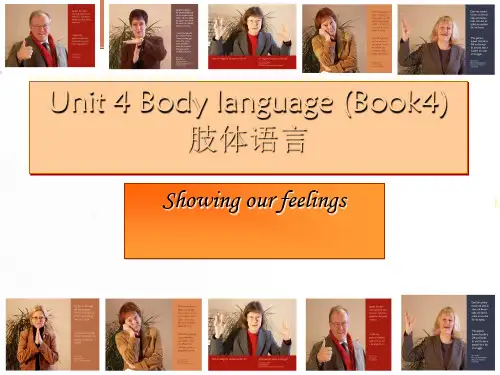
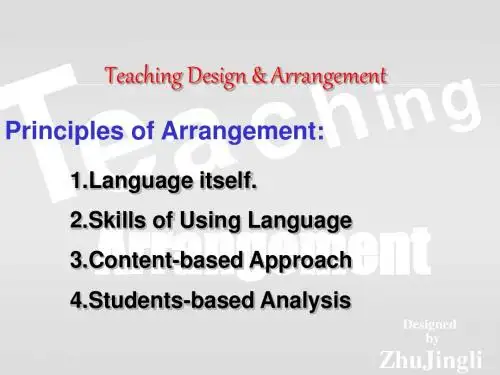
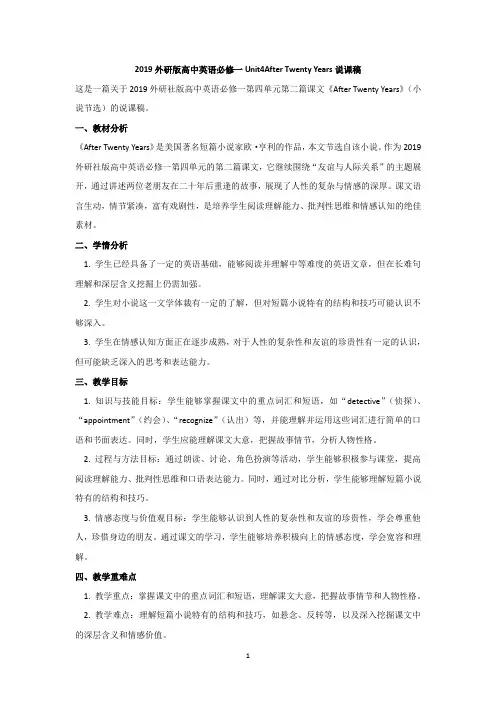
2019外研版高中英语必修一Unit4After Twenty Years说课稿这是一篇关于2019外研社版高中英语必修一第四单元第二篇课文《After Twenty Years》(小说节选)的说课稿。
一、教材分析《After Twenty Years》是美国著名短篇小说家欧·亨利的作品,本文节选自该小说。
作为2019外研社版高中英语必修一第四单元的第二篇课文,它继续围绕“友谊与人际关系”的主题展开,通过讲述两位老朋友在二十年后重逢的故事,展现了人性的复杂与情感的深厚。
课文语言生动,情节紧凑,富有戏剧性,是培养学生阅读理解能力、批判性思维和情感认知的绝佳素材。
二、学情分析1. 学生已经具备了一定的英语基础,能够阅读并理解中等难度的英语文章,但在长难句理解和深层含义挖掘上仍需加强。
2. 学生对小说这一文学体裁有一定的了解,但对短篇小说特有的结构和技巧可能认识不够深入。
3. 学生在情感认知方面正在逐步成熟,对于人性的复杂性和友谊的珍贵性有一定的认识,但可能缺乏深入的思考和表达能力。
三、教学目标1. 知识与技能目标:学生能够掌握课文中的重点词汇和短语,如“detective”(侦探)、“appointment”(约会)、“recognize”(认出)等,并能理解并运用这些词汇进行简单的口语和书面表达。
同时,学生应能理解课文大意,把握故事情节,分析人物性格。
2. 过程与方法目标:通过朗读、讨论、角色扮演等活动,学生能够积极参与课堂,提高阅读理解能力、批判性思维和口语表达能力。
同时,通过对比分析,学生能够理解短篇小说特有的结构和技巧。
3. 情感态度与价值观目标:学生能够认识到人性的复杂性和友谊的珍贵性,学会尊重他人,珍惜身边的朋友。
通过课文的学习,学生能够培养积极向上的情感态度,学会宽容和理解。
四、教学重难点1. 教学重点:掌握课文中的重点词汇和短语,理解课文大意,把握故事情节和人物性格。
2. 教学难点:理解短篇小说特有的结构和技巧,如悬念、反转等,以及深入挖掘课文中的深层含义和情感价值。
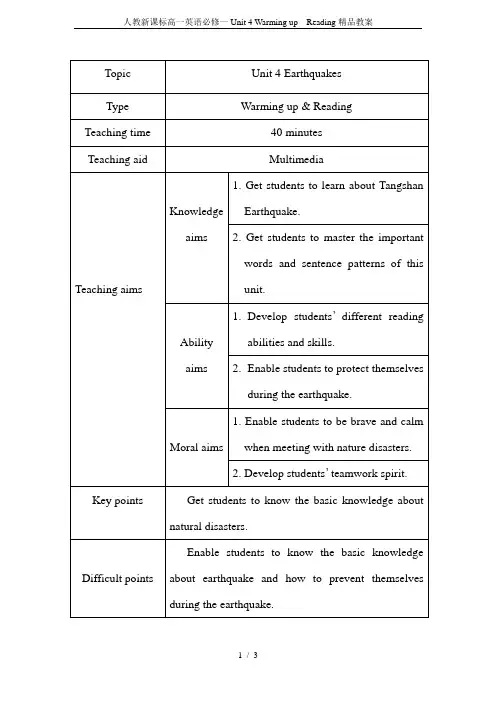
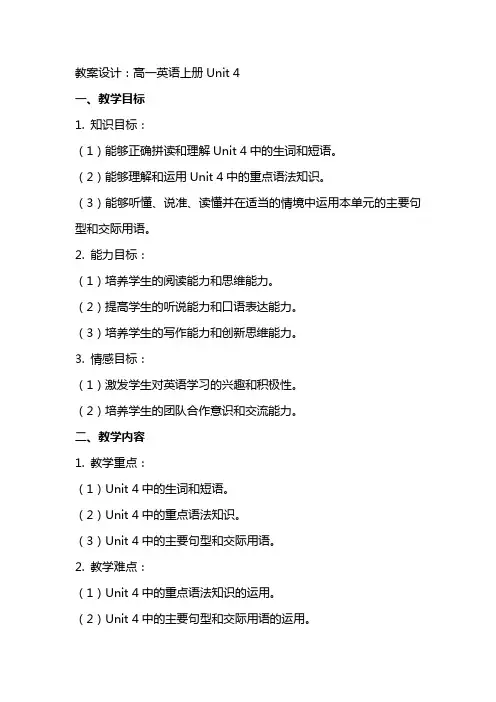
教案设计:高一英语上册Unit 4一、教学目标1. 知识目标:(1)能够正确拼读和理解Unit 4中的生词和短语。
(2)能够理解和运用Unit 4中的重点语法知识。
(3)能够听懂、说准、读懂并在适当的情境中运用本单元的主要句型和交际用语。
2. 能力目标:(1)培养学生的阅读能力和思维能力。
(2)提高学生的听说能力和口语表达能力。
(3)培养学生的写作能力和创新思维能力。
3. 情感目标:(1)激发学生对英语学习的兴趣和积极性。
(2)培养学生的团队合作意识和交流能力。
二、教学内容1. 教学重点:(1)Unit 4中的生词和短语。
(2)Unit 4中的重点语法知识。
(3)Unit 4中的主要句型和交际用语。
2. 教学难点:(1)Unit 4中的重点语法知识的运用。
(2)Unit 4中的主要句型和交际用语的运用。
1. 情境教学法:通过设定各种真实的情境,让学生在实际的语言环境中学习和运用英语。
2. 任务型教学法:通过设计各种实际的任务,让学生在完成任务的过程中学习和运用英语。
3. 交际法:通过模拟真实的交际情境,让学生在交流中学习和运用英语。
四、教学步骤1. 导入:通过与学生生活相关的图片或话题,引导学生进入学习状态,激发学生的学习兴趣。
2. 新课呈现:通过图片、实物、多媒体等辅段,呈现本节课的主要内容,让学生初步感知和理解。
3. 讲解和示范:对生词、短语、语法等进行详细的讲解和示范,让学生充分理解和掌握。
4. 实践和练习:通过各种练习活动,让学生在实际的语言环境中运用所学知识,巩固和提高。
5. 反馈和评价:对学生的学习情况进行及时的反馈和评价,鼓励学生的进步,帮助学生找出问题并加以改进。
五、课后作业1. 复习本节课所学的生词和短语。
2. 完成本节课所给的练习题。
3. 准备下一节课的预习内容。
1. 课堂参与度:观察学生在课堂活动中的参与情况,包括发言、讨论、表演等,以评估学生的学习兴趣和积极性。
2. 练习完成情况:检查学生完成练习的情况,包括正确率、速度和书写规范等,以评估学生的学习效果和掌握程度。
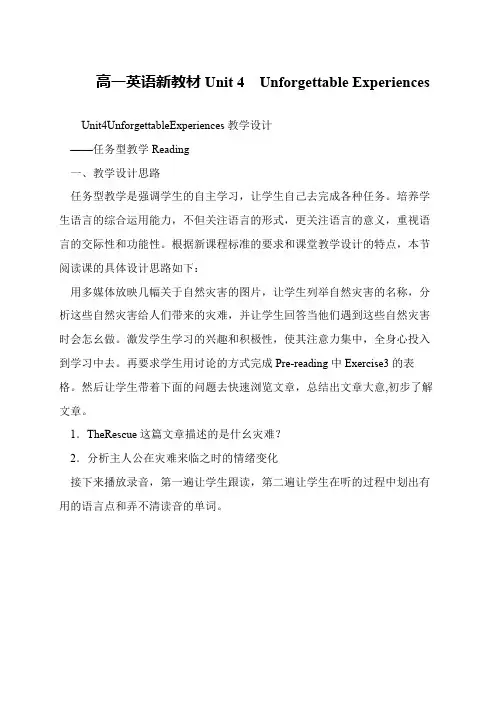
高一英语新教材Unit 4 Unforgettable Experiences
Unit4UnforgettableExperiences教学设计
——任务型教学Reading
一、教学设计思路
任务型教学是强调学生的自主学习,让学生自己去完成各种任务。
培养学生语言的综合运用能力,不但关注语言的形式,更关注语言的意义,重视语言的交际性和功能性。
根据新课程标准的要求和课堂教学设计的特点,本节阅读课的具体设计思路如下:
用多媒体放映几幅关于自然灾害的图片,让学生列举自然灾害的名称,分析这些自然灾害给人们带来的灾难,并让学生回答当他们遇到这些自然灾害时会怎幺做。
激发学生学习的兴趣和积极性,使其注意力集中,全身心投入到学习中去。
再要求学生用讨论的方式完成Pre-reading中Exercise3的表格。
然后让学生带着下面的问题去快速浏览文章,总结出文章大意,初步了解文章。
1.TheRescue这篇文章描述的是什幺灾难?
2.分析主人公在灾难来临之时的情绪变化
接下来播放录音,第一遍让学生跟读,第二遍让学生在听的过程中划出有用的语言点和弄不清读音的单词。
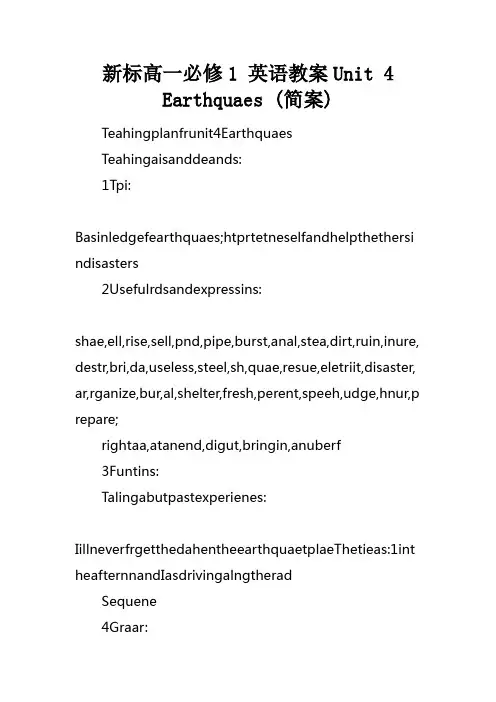
新标高一必修1 英语教案Unit 4Earthquaes (简案)Teahingplanfrunit4EarthquaesTeahingaisanddeands:1Tpi:Basinledgefearthquaes;htprtetneselfandhelpthethersi ndisasters2Usefulrdsandexpressins:shae,ell,rise,sell,pnd,pipe,burst,anal,stea,dirt,ruin,inure, destr,bri,da,useless,steel,sh,quae,resue,eletriit,disaster, ar,rganize,bur,al,shelter,fresh,perent,speeh,udge,hnur,p repare;rightaa,atanend,digut,bringin,anuberf3Funtins:Talingabutpastexperienes:IillneverfrgetthedahentheearthquaetplaeThetieas:1int heafternnandIasdrivingalngtheradSequene4Graar:Theattributivelause由that,hih,h,hse引导的定语从句Thenuberfpeplehereilledrinuredreahedrethan400,000 ItasheardinBeiinghihisnehundrediletersaarersbuiltsheltersfrsurvivrshseheshadbeendestred Teahingpredures:Perid1Step1aringupSsdisussandansersequestins:hihfthefllingaausepeplethegreatestdaage?AearthquaeBtphnfldDdrught2Iagineurhebeginstshaeanduustleaveitrightaauhavetie ttaenlnethinghatillutae?h?Step2Pre-readingSsdisussandanser:Dunhatuldhappenbefreanearthquae?2hatanedteepurselvessafefranearthquae?3DunanthingabutTangshanEarthquaein1976?Step3ReadingSiingandfindtheanserstthefllingquestins:ahathappened?bhenandheredidithappen?2Ssreadagainandfillinthefllingfr:TiehathappenedBefretheearthquaeells:Anials:Lightsandsund:aterpipes:hiletheearthquaeHuses,radsandanals:Hardhillsfr:Thela rgeit:Thepeple:AftertheearthquaeHspitals,fatriesandbuildings:Thegru nd:Das:Railatras:Anials:ells:3Ssreadthehlepassageagainandgettheainideasfeahpar t:Part1ThenaturalsignsfaingearthquaePart2ThedaageftheitaftertheearthquaePart3ThehelptthesurvivrsStep4prehendingSsfinishEx1and2npage27StepAssignentSurftheinternetandgetreinfratinabuttheearthquae2RetellthetextPerid2Step1aringupSssharereinfratinabuttheearthquae2AsseSstretellthetextbusingtheirnrdsStep2Languagepintslie–la-lain:tbe,reainrbeeptinaertainstate处于某种状态ThevillagelainruinsafterthearTheseahineshavelainidlesinethefatrlsed2inruins:severeldaagedrdestred损坏anearthquaeleftthehletninruinsHisareerisinruins3nuber:aquantitfpeplerthings数量;数量Thenuberfpepleapplinghasinreasedthiseareerefifteeninnuberanuberf:altfIhaveanuberfletterstriteAlargenuberfpeplehaveapplied4inure:thurtneself/sb/sthphsiall受伤Hefellffthebileandinuredhisarreah:tahieverbtainsth达到;达到;取得u’llunderstandithenureahageAtlastereahedadeisin6resue:anatfresuingrbeingresued搭救;解救AresueteaistringtreahthetrappedinesResue:tsaversetfreefrhar,indanger,rlss解救;救出Theresuedtheanfrdrning7trap:inaplaefrhihneantstesapebutannt困住;陷于绝境Theeretrappedintheburninghtel8all…nt…=ntall…:sebutntall一些;但不是全数Ntallthegirlsleft=nlseftheleftearlNtallthehildrenarenis=Sefthehildrenarentnis全数否定应用:nnef…NnefuserealledtgthereNnefthesereprtsisverhelpfulStep3learningabutlanguageSsfinishEx1,2and3npage27and282TeaherhestheanserandgivetheSssehelpifthehavesedif fiultStep4assignentFinishbEx1npage632SstrtreebertheusefulrdsandexpressinsbheartsPerid3Step1aringupSsreadthepassageagainandtrtfindthesentenesithattrib utivelausesegrersbuiltsheltersfrsurvivrshseheshadbeendestred Step2AttributivelauseGiveSsresentenesandlettheSstfindthestruturesftheattri butivelause2Ssdseexerisesabuthtusethat,hih,hrhse3SsfinishEx2npage28Seaterialsabutattributivelause:关系代词引导的定语从句关系代词所代替的先行词是人或物的名词或代词,并在句中充当主语、宾语、定语等成份。
高一英语Unit4 Unforgettable experiencePeriod 1. ListeningTeaching objectives and demands:1.The activity is designed to encourage students to think about some unforgettable experience and to activate relevant vocabulary.2.Ask the students to describe a famous person and give examples of situations the person or the accident happened. Use the activity as a brainstorming session done either in groups or with the whole class.nguage use: Manipulate listening, speaking practiceKey points:1. Everyday English for munication.2. Words and useful expressionsTeaching procedures:Step1 Warm up1. Game: Ask students to guess what or whom the teacher is talking about.1) He invented the first telephone in the world. ---------- Alexander Bell2) He is also a great inventor in America. He invented the phonograph and the electric lamp----- ThomasEdison3) He is a Jewish, and he presented the theory of relativity. ----------- Albert Einstein4) He is a very famous cartoon maker. He created Mickey mouse. ----------Walt Disney5) They are American brothers. They invented the plane. ------------Laite Brother2. Tell Ss: We can use attributive clause to describe these persons.e.g. Alexander Bell is the person who invented the first telephone in the world.Ask Ss to give other four sentences using the attributive clause.Tell Ss: All of these people are unforgettable, because what they did have developed human beings’ life. Then please turn to page 22, and look at the four pictures. Please use attributive clause to describe these persons and things.1) Zhang heng is the man who made the earliest seismograph in 132.2) Howard carter is the man who found the King Tut’s tomb in 1937.3) The Titanic is the ship that/which sank after hitting an iceberg.4) Beijing is the city that/which has got the chance to host the 2008 Olympic Games.4. Ask Ss to make up dialogues about these pictures and practice.e.g. ---- Do you know the man in picture 1? ---- He is Zhang heng.---- What made him unforgettable? / How do you know him? ----- he is the man who made the earliest seismograph.Step2 Listening1. Ask Ss to describe the pictures of earthquake.2. Brief introduction: Hank Stram lives in San Francisco with his wife and daughter. On October 17th, 1989 a strong earthquake took place and killed over 100 people. He was caught in the earthquake. Here we will listen to two passages about his own experience.3. Ask Ss to read the questions in part1, and listen to the tape twice. Then ask them to work in groupsto present their answers.a) When did the earthquake happen? ---------- 5:15pmb) Where was the man driving when it happened? -----------on his way to his daughter’s schoolc) What was the first thing he saw? ---------- the car in front started to move from side to side.d) What had he been doing before the earthquake? ---------- he had finished his work and gone to the post office.e) What was he going to do? -------- he was going to fetch his daughter from herschool.4. Listen to the tape again to check and the teacher give necessary explanation.5. Read these five sentences in part2, and then listen to the tape twice, thenfill the blanks.a) I found myself in the dark.b) Then I remembered what had happened.c) It was clear to me now that I had been in an earthquake.d) Then I heard people climbing towards me.e) A team of people had e to see if anyone was under the broken road.6. Listen again to check and make some explanation.7. Ask Ss to tell the whole story (using first, next ,then, finally)Step3 Exercise in the workbook (Page 103)Ask Ss to listen to the tape twice and then plete the table.Evaluation of teaching:Period 2. Speaking and talkingTeaching objectives1.Develop the students’ prehension of explorative passages, especially theirability of speakingand talking ,analyzing the structure of such kind of articles.2.Offer the students chances of self-culture by working in groups and seeking information about thefilm outside the class.3.Infuse the students with basic knowledge about the experience4. Learn some words and useful expressions from the text.Teaching Approach1.municative Approach should be used throughout the class. Stress should be laid on:2.Learner-centeredness; learning-centeredness3.Task-based learning4.Activity-based teaching (class work; individual work; group work)Teaching type: Speaking and talkingTeaching ProcedureStep 1. Report in class A student is asked to report something interesting he or she picks up fromnewspaper or magazines.Step 2.Review and check Ss have a word dictation and check their homework in workbookStep 3. Speaking1. Read the dialogue in P23 in pairs, and act out.2. Give explanations of some phrases in the dialogue.Be good at: do well in For fun: not seriously3. Ask Ss to find out the expressions about offering help, encouraging others and giving advice.--- Don’t worry! / Ju st try / you can do it / Well done! / That was a very good ball.4. Introduce them some other useful expressions.When in danger: Help!When in frighten: It scares me. / I’ m afraid to…When encouraging sb: It will be ok. / e on! / Keep trying. / I t’s all right.5. Ask Ss to describe the three pictures on P23. Then the teacherintroduce the three different situations.Pic1. You have just been saved from a terrible earthquake and you worry about your family.Pic2. Your neighbor will take cars of your favorite pet while you go on a holiday.Pic3. Your house is on fire but there is still a little girl sleeping in the bedroom on the second floor.Then ask Ss to make dialogues according to these situations, using these useful expressions, and choose several pairs to act out.Step 4. Talking1. Give the Brief introduction of the situation: one discovered the tomb of a Chinese King while he was working. He went in and had a look, but didn’t touch anything. Then a scientist came 3 days later, so they began to talk about the tomb.2. Role-play: Ask Ss to work in pairs to make up a dialogue. One acts the person who find the tomb. The other one acts the scientist from Beijing. They can read questions on P103 first, and then choose some of them to make up their dialogues.Step 5. HomeworkworkbookRevise the key points of this Unit.Evaluation of teaching:Period 3. ReadingTeaching objectives1.Develop the students’prehension of reading explorative passages, especially theirability of analyzing the structure of such kind of articles.2. Offer the students chances of self-culture by working in groups and seekinginformation about the film outside the class.3. Infuse the students with basic knowledge about the friend and friendship4. Learn some words and useful expressions from the text.Teaching Approach1.municative Approach should be used throughout the class. Stress should be laid on:2.Learner-centeredness; learning-centeredness3.Task-based learning4.Activity-based teaching (class work; individual work; group work)Teaching type: Reading prehensionTeaching ProcedureStep1. Pre-reading1. Tell Ss: Do you remember Hank Stram’s terrible experience? He was trapped in the earthquake forabout 14 hours .It is really an unforgettable experience for him. As we all know, the earthquake is a kind of natural disasters. Then can you list some other natural disasters?2. Write down their answers on the blackboard---- Flood, Typhoon, Hurricane, Volcanic eruption, Thunder storms, Snow storm, Fire …3. Tell Ss: Among these disasters, I think most of us have experienced the Typhoons, right? Then can you describe what it was like and how you felt? Ask some Ss to give their ideas.4. Pose question: If you are riding a bicycle on the road, and the typhoon is ing, then what would you see / feel / do? Please use first, next, then, and finally in your description.Ask two or three Ss to give their description.5. Pose question: Have you ever experienced such natural disasters?If yes, ask them to describe. If no, ask them to use their imagination and discussin groups to describe what would they see / feel / do in other situations. Then choose several groups to present their ideas using first, next, then, and finally.Step2. While-reading1. Pose a question: What is the text about? --- About how Flora and Jeff rescue themselves in the flood.2.Listen to the tape once, and ask them to answer questions:What happened to them finally? ---- SurviveHow did they make it? ---- Stay in the room with a chimneyWhy? --------It’s the strongest part of the house. (Para 8 and Para 11)3. Ask Ss to read the whole passage carefully, and then fill in the table below.4. According to the table, ask Ss to catch the main idea of the whole story. Choose some Ss to retell.5. Language studyParagraph 11) Heard somebody shouting / saw Jeff runningSee / hear sb doing -------- I heard him singing next door last night.See / hear sb do ------- I heard him sing next door.pare the differences between the two.2) The attributive clause: it’s a part of a sentence, and tells us which person or thing(or what kind of person or thing)the speaker means.3) Look around:4) Roar: (n) loud and deep sound of a lion ,thunder, or a person in pain(v) make loud and deep sound5) Advance: (v) move forward or develop --- Our troops ~d two miles.---- The water is ~ing on/upon/towards her.(n) in advance: beforehand --- if you want to e here for your holiday, please call me ~.6) Be upon: be close toParagraph 27) Seize: take hold of suddenly and violentlyParagraph 38) Sweep : clean and clear away --- e.g. sweep the dust from the carpetssweep down: knock down by the watersweep away (Para 9)—e.g. s~ the dead leaves9) Swallow: allow to go down the throat, here means she was taken in by the water and disappeared.10) Drag: pull along with effort and difficulty11) Go down :go lower; set ---- e.g. The price of egg has gone down.The sun is going down.Here means they were swallowed by the waterGo through: pass --- e.g. A terrible noise went through the house. (Para 10) experience, suffer --- e.g. ~ hardshipsParagraph 412) Against: indicating support and close --- e.g. place the ladder ~ the wall13) Struggle: make great effortsStruggle against --- e.g. ~ against difficulties14) Get on her feet: stand up15) Fight for her life: try her best to rescue herself16) Look into: stare at--- e.g. Jeff and Flora looked into each other’s face.examine, investigate --- e.g. ~ a question17) With a look of: here look is a noun, and means appearance on one’s face18) Fright: fear ----- e.g. give sb a ~; take ~ at sthFrighten (v) :scare ---- e.g. The great noise ~ed me.Paragraph 619) Flow: move along as a river does ------ e.g. Rivers ~into the sea.The tears ~ed from her eyes.Paragraph 720) Strike: hit, give a blow to ---- e.g. ~ while the iron is hot.The clock is ~ing 12.21) Cracking noise: When the house was broken with lines of division, it made such sudden sharp noise.Paragraph 822) Fall down: crash, break down /fail --- e.g. ~ on one’s promiseParagraph 923) Noun + after + Noun : indicating the succession. Tree after tree; day after day; year after year24) Must have done: He is sleepy this morning. He must have slept very late last night.Must be doing: e.g. I hears loud voices next door. They must be quarrelling.Must do: e.g. He is Tom’s best friend. He must know his .Step3. Post-reading1) Ask Ss to find these sentences below and then work out what the underlined words refer to?Before she could move, she heard a loud noise, which grew to a terrible roar. -------a loud noiseThere she saw a wall of water that was quickly advancing towards her. ------behind herShe wanted to watch it. --------- a wall of waterFlora, whose beautiful hair and dress were all cold and wet, started crying. ---------- flora’sFor some moments both were silent. --------- Jeff and Flora2) Do the exercises in page26Step 8. Homeworkworkbook ReadingRevise the key points of this Unit.Period 4. GrammarTeaching aims and demands1.The students are asked to master the Grammar :2.Integrating Skill: reading3.Oral practice: manipulate oral practice relevant to the reading material.Key points: grammar and readingTeaching methods: Reading —Sentence structure----explanationTeaching procedures:Step 1. Revision(1) Check the homework exercises.(2) Revise the key points of the previous lesson.Step 2. Warming upPlay a game: The teacher describe sb or sth and ask Ss to guess.If a person likes reading very much, we call him a bookworm.If a person loves to play or watch sports, we call him a sports fan.If a person often works very hard, and seldom stop working, we call him a workaholic.If a person often spends a lot of time watching TV, we call him a cough potato.If a person can municate with you on the Internet, we call him an e-pal.If a machine can tell us time, it is a watch or a clock.If a machine can fly in the sky, it is a plane.Step 3. Lead in1. Tell Ss: We can use the attributive clause to describe these persons and things.e.g. A bookworm is a person who likes reading very much.A plane is a machine that / which can fly in the sky.Ask Ss to use the attributive clause to describe the people and things that you have guessed in the warming up.A sports fan is a person who loves to play or watch sports.A workaholic is a person who works very hard.A cough potato is a person who often spends a lot of time watching TV.An e-pal is a person whom / who we can municate with on the InternetA clock is a machine which / that can tell us time.2. Tell Ss: In the attributive clause, we will use the relative pronouns. when we talk about people, we can use who, whom, whose and that. When we talk about things, we can use which and that.3.Give explanation and examples.1) She looked at Jeff who was waving his arms. ----- She looked at Jeff. Jeff was waving his arms.2) The man to whom you talked is Mr. Li. ----- The man is Mr. Li. You talked to the man.3) The story that / which yo u read is “ The Rescue”. ---- The story is “The Rescue”. You read the story.4) Do you know the boy whose parents are on holiday? ---- Do you know the boy? Theboy’s parents are on holiday.4. Then ask Ss to make up sentences, using the attributive clause to describe other people and things as we did above.5. Do the exercises 1 in P26 and P105 ----- fill the blanks6. Ask Ss to bine two sentences into one ,using the attributive clause. (exercise 2 in P105)Step 4 HomeworkFinish off the work in work bookTry to write a news story in about 100 wordsRevise the grammarEvaluation of teaching:Period 5. Integrating skillsTeaching aims and demandsIntegrating SkillGrammar and writingGet the students to write an emailKey points: 1. Useful expressions; 2.writing 3.grammarTeaching methods: Written practice and grammar.Teaching proceduresStep 1. Revision(1) Check the work exercises.(2)A test for unit 4Step 2Post- Integrating skill1. Listen to the tape once, and pose questions:what is the passage about? ------ about a travelwhere do they travel? -------- SichuanProvince (MountEmei, Leshan)2. Read the whole passage again, and then fill in the table on the blackboard.Going on a trip to Leshan and Emei3. Ask Ss to red again and then retell the whole story according to the table on the blackboard.4. Give necessary explanationsAsk Ss to find out all the attributive clause and the linking wordsEncourage Ss to use such clause and linking words.Step 3. Summary in Unit 4Ask Ss to talk about their own travel or some unforgettable experience Step 4WritingAsk the Ss to write an article on an experience to some place.Do the reading in P106Assignment: write an essay about an unforgettable experience of the Ss’Step 5. Homework(1) Finish off the exercises in the workbook.(2)Write an email into my email-box.(3)Summary the key points in this unitEvaluation of teaching:。
新教材高一英语Unit 4说课教案 一.教学目标 理论依据:《新课程标准》(实验稿) 根据《新课程标准》(实验稿)关于总目标的定位及其实现途径和目标具体描述,结合高一学生实际和教材内容,我们把本单元的教学目标定为: 1) 语言知识: 单词:理解、内化、运用以下生词:seismograph; iceberg; King Tut; // roar; fright; crack; // bookworm; couch potato; workaholic;// Buddha; agent等,扫除听读障碍,重点掌握一些传神动词:advance; seize; sweep; swallow; drag; pull; flow; shake; strike; struggle等。 词组:get on one’s feet; tree after tree 语法:复习和运用定语从句用于描述人、物及事件。 2) 语言技能: 听:听懂一个关于不幸经历的小故事,抓住时间、地点、人物、发生的事件 说:能用得体语言描述人、物、事件,并且有一定的逻辑。 读:Scanning, skimming, careful reading, generalization; inference等阅读微技能训练。 写: 能运用First, Next, Then, Finally简要且富有逻辑地描写自己的一次难忘经历。 3) 学习策略:学生一定程度形成自主学习,有效交际、信息处理、英语思维能力。 4) 情感态度:学生能在多种英语学习情景中分享自己的幸与不幸,体验用英语交流的成功与喜悦,以及培养合作精神、互助精神。 二.教学重点和难点: 重点:1. 课文中出现的重要动词,如:advance, seize, sweep, swallow, strike, struggle, drag, flow, shake, 及词组 get on one’s feet, pull oneself, tree after tree etc. 2. 用关系代词who, that, whom, whose等引导的定语从句 . 3. 用副词 first, next, then, finally 来描述一场难忘的经历. 难点: 能用得体的英语表达自己,描述过去的难忘经历。 三. 教学方法
根据我们几年来二语习得论、“整体语言教学”的理论和实践,以及当前教学改革,课程改革等先进理念,为达成上述教学目标,运用任务型教学途径,我们英语课堂设计采取“P---T---P”自主学习立体模式:(Pre-task----Task-cycle----Post-task)。 四. 教学安排 根据学生学习英语的特点和规律,学习阶段的侧重点以及高一学生的发展,我们把本单元划分为6课时:听力、口语、阅读(2课时)、语言(0.5课时)、写作、评价(0.5课时)。下面请看我们的课堂教学设计。 Period I warming up and listening Ⅰ、教材内容及教学目标 本课处于本单元的第一课时,主要训练和提高学生‘听’的技能,它的掌握有利于以下几课的‘说’、‘读’和‘写’的技能训练,并作了一个很好的铺垫.本课的听力材料由两部分组成,主要讲述Hank Stram在地震前所做、地震中所见、所闻和所感的令人难忘的经历。通过完成练习,学生能抓住所听语段中的关键词、理解话语之间的逻辑关系、听懂故事、理解其中主要人物和事件以及他们之间的关系等。而且学生能掌握较好的听力方法,如积极预测、注意抓关键词、善于跳跃难点、学会做笔记等等。通过本课学习学生能复习定语从句以及学会正确使用指人或物的关系代词. Ⅱ、教学设计 A. Warming up : Task 1 Matching competition (group work) Column A Column B 1、 Fu Jian Province a、a cartoon maker 2、 San Francisco b、the electric lamp 3、 Alexander Bell c、the first telephone 4、 Thomas Edison d、earthquake 5、 Albert Einstein e、typhoon 6、 Walt Disney f、the Theory of Relativity Question: Why do you think so ? Task2: Looking at the following pictures, find out the answers to the questions: 1) Do you know who or what they are ? 2) What made them unforgettable? 3) Can you describe each picture using one sentence( with the help of the words under the picture) Task 3: Let the students describe each picture with Attributive Clause. eg: Zhang Heng is the man who made the earliest seismograph in 132. B. Pre-listening Task1: Before listening , let the Ss guess the possible answers to the following questions according to the situation: (group work) 1) When did the earthquake happen? 2) Where was the man driving when it happen? 3) What was he going to do? Listening(Part 1): Task 2: Listening to the tape to get the correct answers to the above questions.(for the first time) Task 3: Listening to the tape to put the following into the right order. ( ) 1. I stopped the car and at the same time the road fell onto the cars in front of me. ( ) 2. I was hungry so I started to eat one. ( ) 3. I saw the cars in front of me start to move from side to side. ( ) 4. I had finished work and then gone to the Post Office. ( ) 5. I slowed down ,then my car started to shake. ( ) 6. I stopped off at a shop in order to get some fresh fruit. ( ) 7. I drove even slower, then the road above started to fall down. Task 4: Letting the Ss listen to the tape again, then try to retell the story simply, using their own words. Task 5 : Discussion (Group work) What would happen to Hank Stram finally? Listening (Part 2) Task1: Listening to the second part to choose the best choices(for the first time) 1. Which part of his body hurt badly?( C ) A. The bottom parts of his legs B. The bottom parts of his hands. C. The bottom parts of his legs and feet. 2. What could he hear below him?( B ) A. Nothing B. Shouts and noise C. The noise of cars 3. How long had he been in the car?( A) A.14 hours B. 40 hours C.4 hours Task 2: Listening to the tape again to write the words in the spaces. 1. I ________ myself in the dark. 2. Then I remembered what______. 3. It was clear to me now that I ______ in an earthquake. 4. Then I ________ people________ towards me. 5. A team of people______ to see if anyone _____ under the broken road. C. Post-listening: Task 3: Discussion What made him survive in such a terrible accident? Period 2 Speaking Ⅰ、教材内容及教学目标 本课着重培养学生‘说’的技能, 通过复习、学生自我介绍、解说图片、自编对话等手段来巩固定语从句中指人的关系代词who or whose 的用法,达到能有条理地描述个人体验和表达个人的见解和想象、能传递信息并就熟悉的话题表达看法、能用英语进行语言实践活动。它的掌握是一个很好的过渡阶段―――进入‘读’和‘写’的技能训练. Ⅱ、教学设计 Pre-task: 活跃学生用英语交流的思维, 通过复习引出本课的重点---定语从句中指人的关系代词who or whose 的用法 。 Activity 1. Revision Task: Talking about Hank Stram and his unforgettable experience. Ask some Ss some questions about Hank Stram and his unforgettable experience first, then write down two sentences on the Bb: 1. A man whose name was Hank Stram was caught in the earthquake on October 17th , 1989 in San Francisco. 2. Hank Stram was a lucky man who was rescued after he had been in his car for 14 hours. Purpose: 1、活跃学生用英语交流的思维。 2、通过复习引出本课的重点---定语从句中指人的关系代词who or whose 的用法 。